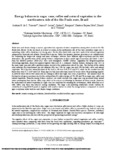Please use this identifier to cite or link to this item:
http://www.alice.cnptia.embrapa.br/alice/handle/doc/1055656| Title: | Energy balances in sugar cane, coffee and natural vegetation in the northeastern side of the São Paulo state, Brazil. |
| Authors: | TEIXEIRA, A. H. de C.  LEIVAS, J. F.   RONQUIM, C. C.   SILVA, G. B. S. da   VICTORIA, D. de C.   |
| Affiliation: | ANTONIO HERIBERTO DE C TEIXEIRA, CNPM; JANICE FREITAS LEIVAS, CNPM; CARLOS CESAR RONQUIM, CNPM; GUSTAVO BAYMA SIQUEIRA DA SILVA, CNPM; DANIEL DE CASTRO VICTORIA, CNPTIA. |
| Date Issued: | 2016 |
| Citation: | Proceedings of SPIE - International Society for Optical Engineering, v. 9998, p. 99980M-1-99980M-16, 2016. |
| Description: | Under land and climate change scenarios, agriculture has experienced water competitions among other sectors in the São Paulo state, Brazil. On the one hand, in several occasions, in the northeastern side of this state, nowadays sugar-cane is expanding, while coffee plantations are losing space. On the other hand, both crops have replaced the natural vegetation composed by Savannah and Atlantic Coastal Forest species. Under this dynamic situation, geosciences are valuable tools for evaluating the large-scale energy and mass exchanges between these diffe rent agro-ecosystems and the lower atmosphere. For quantification of the energy balance components in these mixed agro-ecosystems, the bands 1 and 2 from the MODIS product MOD13Q1 we re used throughout SA FER (Surface Algorithm for Evapotranspiration Retrieving) algorithm, which was applied together with a net of 12 automatic weather stations, during the year 2015 in the main sugar cane and coffee growing regions, located at the no rtheastern side of the state. The fraction of the global solar radiation (R G ) transformed into net radiation (Rn) was 52% for sugar cane and 53% for both, coffee and natural vegetation. The respective annual fractions of Rn used as λ E were 0.68, 0.87 and 0.77, while for the sensible heat (H) fluxes they were 0.27, 0.07 and 0.16. From April to July, heat advection raised λ E values above Rn promoting negative H, however these effects were much and less strong in coffee and sugar cane crop s, respectively. The smallest daily Rn fraction for all agro-ecosystems was for the soil heat flux (G), with averages of 5%, 6% and 7% in sugar cane, coffee and natural vegetation. From the energy balance analyses, we could conclude that, sugar-cane crop presented lower annual water consumption than that for coffee crop , what can be seen as an advantage in situations of water scarcity. However, the replacement of natural vegetation by su gar cane can contribute for warming th e environment, while when this occur with coffee crop there was noticed co oling conditions. The large scale modeling satisfactory results confirm the suitability of using MODIS products togeth er with weather stations to study the energy balance components in mixed agro-ecosystems under land-use and climate change conditions. |
| Thesagro: | Sensoriamento Remoto |
| NAL Thesaurus: | remote sensing |
| Keywords: | Net radiation Latent heat flux Sensible heat flux Agro-ecosystems Saldo de radiação Fluxo de calor latente Fluxo de calor sensível Agro-ecossistemas |
| Type of Material: | Artigo de periódico |
| Access: | openAccess |
| Appears in Collections: | Artigo em periódico indexado (CNPM)  |
Files in This Item:
| File | Description | Size | Format | |
|---|---|---|---|---|
| PapersugarcanecoffeeHeriberto16.pdf | 4.42 MB | Adobe PDF |  View/Open |









